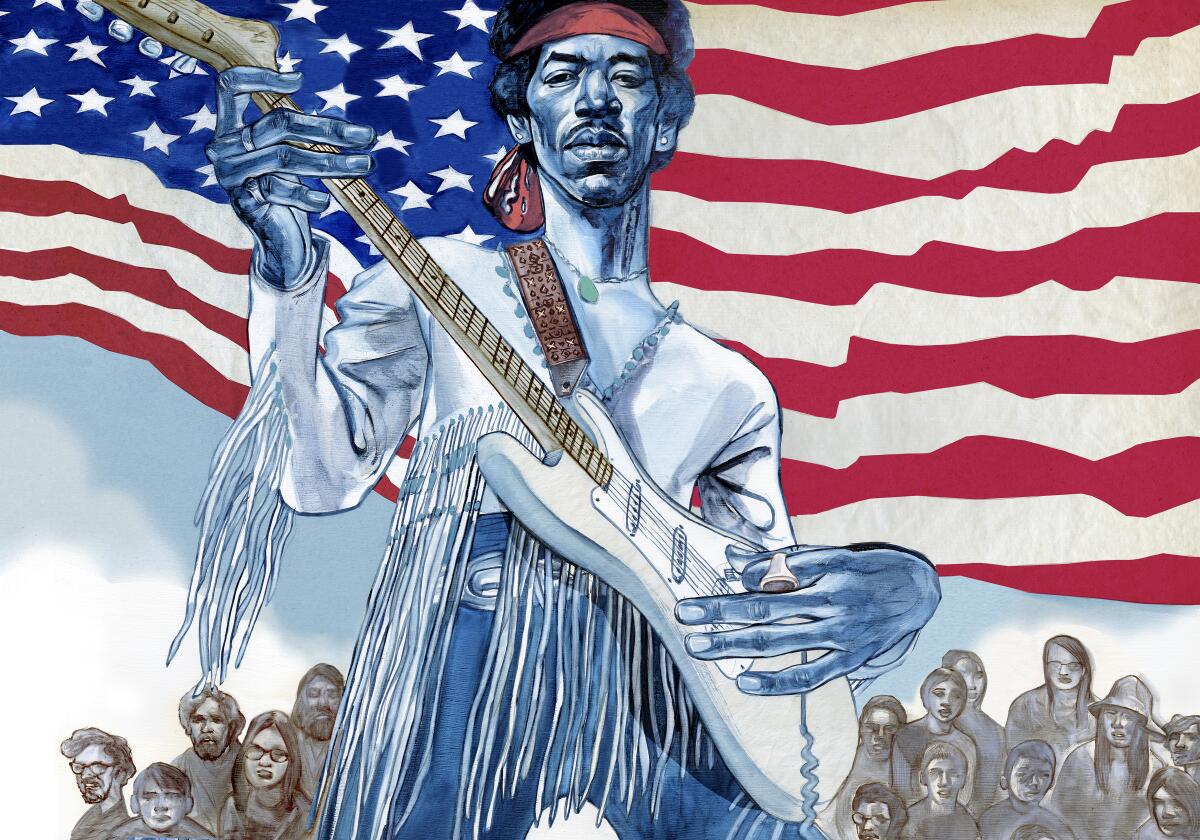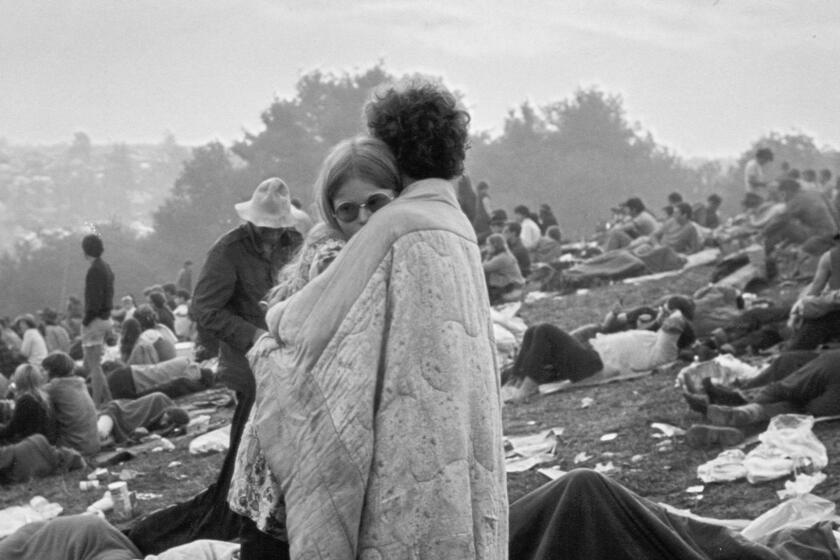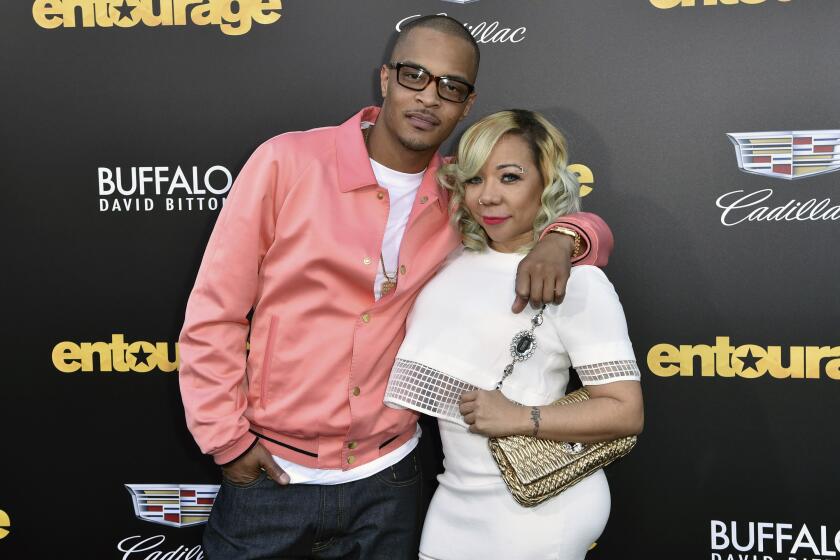Jimi Hendrix’s ‘Star-Spangled Banner’ is the anthem we need in the age of Trump

As the rare active rock critic who attended the 1969 Woodstock Music and Art Fair, I spent two weeks in July touring upstate New York with my wife, hoping no one would try to interview me about it. It was what it was, mind-blowing in its way but always less epochal than legend had it, and in the most parlous political juncture of my lifetime, I had more urgent matters on my mind.
The ’60s were with us still, as they deserved to be. In the hippiefied Ithaca suburb of Trumansburg, one of many communities nationwide where counterculture dreams have evolved into workable economic principles, we caught the tail end of the 29th annual GrassRoots Festival, where 20,000 jam-banders from ages 10 to 80 grooved to uncountable folk/rock subgenres, and East Nashville malcontent Todd Snider scored more political barbs in an hour than any Woodstocker but Country Joe McDonald did in a career. In Erie Canal country we choked up at Seneca Falls’ Women’s Rights National Historical Park and devoutly hoped Auburn’s Harriet Tubman house would equal it soon.
But in the southwest quadrant of Adirondack Park, our mood shifted. The cordial motel owner running for local office as a Republican and the NRA sticker on her husband’s gorgeous restored black ’46 Chevy pickup were only to be expected. But not the spectacle we encountered when we explored one side road: American flags hanging, often limply as if half dead, from every single house and pole. It was a disturbing image. So when The Times asked me to write about Jimi Hendrix’s “Star-Spangled Banner,” it felt like maybe I had something to say about Woodstock after all.
Fifty years on, America remains obsessed with Woodstock. Here are the best recordings, movies and books to accompany your weekend nostalgia trip.
Relatively few zonked rock fans heard the only important piece of music to come out of the 1969 get-together. By the time Hendrix’s barely rehearsed Gypsy Sun & Rainbows six-piece came on to close the festival at 8 a.m. Monday, the weekend’s 400,000 celebrants were down to 40,000 or less — a good crowd, obviously, but not a mythic one. On my way home myself by then, I can only guess that it added latecomers, locals and crazies to a portion of the few celebrants who spent the weekend near the stage.
If only because it was physically impossible, most of us didn’t. Insofar as Woodstock was magical, music was the occasion of that magic, not the cause. In 1969, when amplification in a 40,000-capacity stadium was a challenge unsolved, a natural basin accommodating 10 times that many was altogether out of reach. Though up front the audio may have been immersive, at who knows what cost in clarity and incipient tinnitus, further back and all around it was merely adequate. There the onstage sounds functioned as background music for enjoying the vibes, hanging out with friends, schmoozing with strangers, skinny-dipping in the woods, and digging what we knew was an amazing piece of history.
Woodstock’s music was less than epochal anyway. Among the missing were the Beatles-Stones-Dylan triumvirate and all of black “soul,” save the rock-certified Sly and the Family Stone. Not one of the other big-name sets became canonical, and too many were subpar — Crosby, Stills, Nash & (sometimes) Young’s second live show ever, Jefferson Airplane resenting their own 8 a.m. slot, Janis Joplin making like a pro for an audience she found too huge to relate to. When 1970’s “Woodstock” triple-LP came out, my second-favorite track was the historically negligible Ten Years After’s rockabilly-spiked speed boogie “I’m Going Home,” and after too much double-checking it still is. But it’s dwarfed by my favorite.

Gypsy Sun & Rainbows comprised Hendrix, his longtime drummer Mitch Mitchell, bassist Billy Cox, percussionists Juma Sultan and Jerry Velez and backup guitarist Larry Lee. Sultan and Velez are hard to make out on the Hendrix “Woodstock” album that finally came out in 1994, Lee impossible, but the other three render this condensed and reordered version of their festival performance one of the more striking of the uncountable live Hendrix albums to appear since he died in 1970. Scheduled for 11 Saturday night, Hendrix’s troupe trucked in two hours early and went on nine hours late because that’s how far behind things were — the promoters offered him the prime midnight slot but his manager insisted that he close the festival.
“I see that we meet again. Hmmm ...” Hendrix began, and after admitting that they’d only rehearsed twice, nailed the “prime rhythm thing” “Fire” before introducing the unreleased “Izabella”: “Gonna do a song dedicated to maybe a soldier in the Army, singin’ about his old lady that he dreams about and humpin’ a machine gun instead. Or it could be a cat maybe tryin’ to fall in love with that girl-baby, but a little bit too scared. That’s where the problems come from sometimes, isn’t it? I mean the cat really insecure a little bit, so they call girls groupies and they call girls this and they call passive people hippies and blah blah woof woof on down the line.”
After “Izabella” follow uncommonly deliberate and soulful versions of the great Hendrix warhorses “Hear My Train a Comin’” and “Red House,” an eight-minute new Hendrix copyright aptly titled “Jam Back at the House (Beginnings)” that stiffens slightly before it blooms into fast picking and far-out sonics, and an incendiary “Voodoo Child” that crumbles almost distractedly into just the first verse of the forgettable Hendrix original “Stepping Stone.” Why was this apparent misstep preserved on a carefully edited reconstruction of a longer set? I figure verisimilitude, because what comes next is what actually segued out of “Stepping Stone” on that long-lost Monday morning and etched Hendrix’s performance into history.
It’s generally believed that “The Star-Spangled Banner” climaxed Woodstock. In fact Hendrix ended the festival by sandwiching two improvisations between the stoned “Purple Haze” and the sexist “Hey Joe.” It’s generally believed that he’d never performed it before. In fact he’d been dropping it into his sets for a year. But these false memories only point up the enduring shock value of Hendrix’s deconstruction of our national anthem. Some of the sonics he inserts throughout have editorial content — dive-bombing effects begin after “rockets’ red glare,” “Taps” interpolations follow at “flag was still there,” in one interlude bombs are definitely dropping, and Mitchell drums up a barrage of his own throughout. But mostly Hendrix is just translating this awkward old melody into a rock dialect that only he could articulate in the summer of ‘69, before his army of imitators figured out how to mimic it.
The tune itself is a notoriously resistant one — the high note that tops off “land of the free” has soured many sporting events. But it was also a standard when in 1814 Francis Scott Key lifted it whole from “To Anacreon in Heaven,” a drinking song that it turns out was also a sex song: “And besides I’ll instruct you, like me, to entwine / The myrtle of Venus with Bacchus’ vine.” Just right for an artist into making love and getting high, you might think, but there’s next to no chance Hendrix knew that and plenty that he related to “The Star-Spangled Banner” as a former schoolboy.
“I’m American so I played it. I used to have to sing it in school, they made me sing it at school,” he told TV host Dick Cavett a few weeks later, and when Cavett called his rendition “unorthodox,” responded, “I thought it was beautiful.” Nor was this just a hipster pulling a square’s leg, because Hendrix also played it as an ex-serviceman. He turned 19 in the Army’s 101st Airborne Division, and though he soon wiggled out of military service, he never renounced it, always remembering his Army buddies, who included bassist Cox and machine gunners like the one he imagined at Woodstock.
Jimi Hendrix loved to flash the peace sign, as he did both at Woodstock and on Cavett’s show. He loved the counterculture that made him a hero, too. But like most musicians he was more a hippie than a peacenik, much less a radical, known to defend the Vietnam War in conversation back when he started playing “The Star-Spangled Banner” live. His politics were still evolving as of Woodstock and after — most people’s were. And for sure he meant to claim the national anthem for his white, groovy, long-haired, spaced-out tribe. So he tore it down and built it up back up into something so avant and anarchic that peaceniks and radicals have taken it for their own ever since.
That’s because what matters about this “Star-Spangled Banner” isn’t what Hendrix thought it was, if he even knew exactly. Rather it’s what he meant to leave us free to think it was. Thus it’s an image of America that Americans dismayed by what America has become can cherish. Amid the blah blah woof woof of flag-pinned liars and flag-waving know-nothings, it’s a way for those of us who thought America would never have to fight fascism again to remember that we’re doing so to make our beloved nation the land of the free and the home of the brave.
Robert Christgau’s 2017 Duke University Press collection “Is It Still Good to Ya?” was shortlisted for a National Book Critics Circle award.
More to Read
The biggest entertainment stories
Get our big stories about Hollywood, film, television, music, arts, culture and more right in your inbox as soon as they publish.
You may occasionally receive promotional content from the Los Angeles Times.











